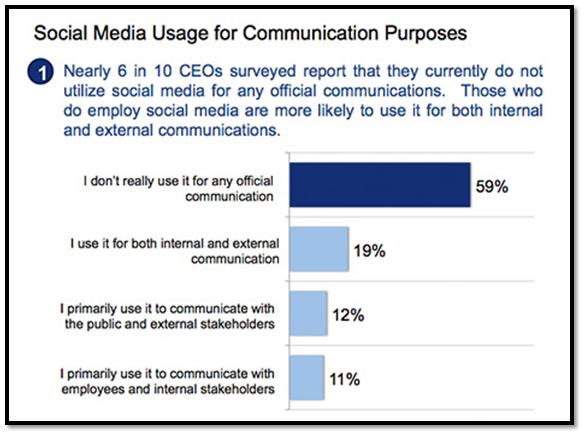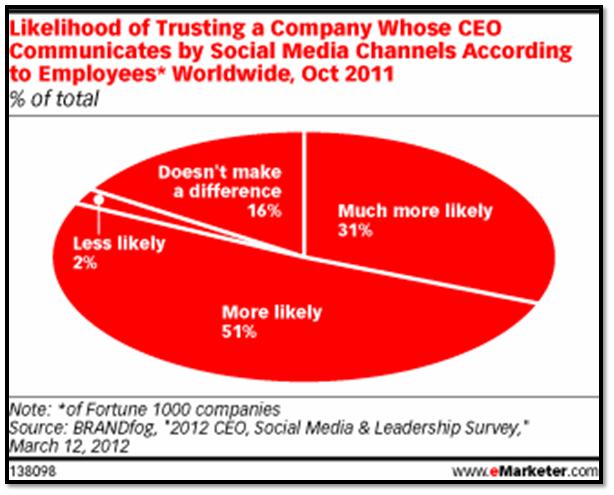Another week, and another study comes out about how America’s captains of industry don’t “get” social media. CEO Connection’s Lisa Petrilli reports that her company has revealing new research among heads of companies with revenues of over $100 million.
Her findings?
Nearly six in ten (59%) don’t use social media for any official communications. Yes, it’s OK to gasp.
The study also reveals that six in ten (61%) use social media as a tool to gain a better understanding of what the public is saying about their brands and products.
Of course, the reverse is significant: nearly four in ten (39%) apparently see no value in using social media platforms to gain insights about what people are saying and thinking. That data point is shocking, especially for companies of this size.
Petrilli mentions it, as does Lori Lewis at our company that it can be as simple as setting up simple Google Alerts for a company which provides an easy and minimal way of tracking chatter about a brand or radio station.
Petrilli also points out that past studies have shown that brand trust is considerably higher among companies whose CEOs utilize social media:
For CEOs who are always talking about ROI and statistical proof that a given activity or investment is effective, how much more evidence do you need?
And now for the good news…
There is more and more evidence that corner office social media use is accelerating. I have mentioned David Field’s tweeting activity in this blog. It has clearly spurred more interest in Twitter among his own employees, but also sets a very different tone for Entercom.
It’s not an isolated event. At the Conclave last week, we featured Chris Iles, the Minnesota Twins’ corporate communications manager. Chris had some wonderful insights about how an active sports franchise is using social media, and there were great analogies for radio.
I asked him whether it was difficult gaining buy-in from his baseball bosses, and he told me that they’re all in, they believe in the power of social media to build engagement and revenue, and that the Twins’ president, Dave St. Peter, personally uses Twitter to connect with fans and the community.
This accessibility and presence is important for corporate leadership, especially at a time when the team is under-performing. The Twins are having a rough year, all the more reason why staying connected with fans is essential during a downturn.
At the Conclave, we also heard evidence that social media is becoming a high priority for broadcasters, including smaller companies looking to make an impact by building brands that specialize in the digital arts.
James Derby, Federated Media’s director of interactive media, was a panelist on “New Ways To Make Money?” Who was the driving force behind his company’s successful digital division? Its president, Alec Dille.
Similarly, Hubbard’s Rob McCracken was asked who championed his cluster’s “2060 Digital.” It was cluster manager Jim Bryan (with the blessing of Hubbard’s corporate folks).
In each case, success for companies that don’t own hundreds of radio stations boils down to seizing opportunities in local markets to generate revenue, extend reach, and increase influence. And it’s the leaders at or near the top who are recognizing the potential to try new things.
Paul Jacobs moderated this session, leaving you with the palpable feeling that radio can turn this corner, but it is going to require the total buy-in from the upper regions of every broadcast company in America, as well as the RAB, NAB, Katz, and state broadcaster associations.
It starts with vision at the top. If you want to evaluate your company’s future, just look up.
- Media And Technology In 2025: Believe It Or Not! - April 18, 2025
- In Radio, You Just Never Know - April 17, 2025
- The Secret To Making A Great Podcast (And Great Radio) - April 16, 2025






Another recent study done by Domo, called the “2012 Fortune 500 Social CEO Index,” shows similar findings though in this study it’s a whopping 70% that have no social media presence at all. While their usage of LinkedIn is higher than the general public, this study found that only 8% of Fortune 500 CEO’s use Facebook and only 4% use Twitter. It’s also notable that only 6% use blogs to communicate. Clearly these captains of industry have a lot of work to do in the area of social media and as this blog shows, the ROI of doing so is immense.
https://www.domo.com/company/press-releases/160
Agreed. Thanks for adding this into the discussion, Bill.
This is an interesting dilemma on two fronts.
First there’s the age issue. Most CEO’s are older than people who use social media regularly, so they just don’t “get it” and aren’t comfortable communicating, especially officially, with a medium they don’t fully understand.
Second, many CEO’s, especially big company ones don’t communicate directly with most employees. They have VP’s and Presidents of operating companies who report to them and most of their communication is with them. Social media is often way more spontaneous and timely than CEO’s are used to being. Their communication sets the tone for their organization and much of their success rides on how effective they are at communicating their vision. As such, its usually crafted and edited – by writers and sometimes by lawyers.
People communicate differently than they used to – especially people under 40. CEO’s need to get understand that and embrace it. The age of written, rewritten, edited and “lawyerized” CEO-speak may be coming to an end. Communication is about the receiver, not the sender and social media is melting those time honored corporate layers quickly. CEOs need to jump in, lest they appear out of touch and too old to connect.
Bob, you make some great points here. While the audience has changed the way they entertain themselves, the same is true of younger employees. Thanks so much for taking the time to comment.